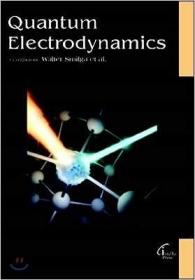
现货Quantum Electrodynamics[9781682510308]
¥ 1434 九五品
仅1件
上海宝山
认证卖家担保交易快速发货售后保障
作者Walter Smilga
出版社Intelliz Press LLC
ISBN9781682510308
出版时间2016-01
装帧精装
纸张其他
正文语种英语
上书时间2023-08-08
- 最新上架
商品详情
- 品相描述:九五品
- 商品描述
- Quantum electrodynamics is a quantum field theory of the electromagnetic force. Taking the example of the force between two electrons, the classical theory of electromagnetism would describe it as arising from the electric field produced by each electron at the position of the other. The force can be calculated from Coulomb’s law. The quantum field theory approach visualizes the force between the electrons as an exchange force arising from the exchange of virtual photons. Quantum electrodynamics applies to all electromagnetic phenomena associated with charged fundamental particles such as electrons and positrons, and the associated phenomena such as pair production, electron-positron annihilation, Compton scattering, etc. The text Quantum electrodynamics is intended to provide the theories of fundamental interactions of matter, the strong force, the weak force, and the gravitational force. First chapter focuses on reverse engineering approach to quantum electrodynamics. Second chapter describes the background and results of revised quantum electrodynamic theory, summarizing the weak points of conventional theories, the unification of included fundamental concepts, the present basic field equations, new obtained results, and special points of experimental support. Third chapter introduces a new scalable cavity quantum electrodynamics platform which can be used for quantum computing and fourth chapter reviews on electrodynamics. Fifth chapter focuses on self-localized quasi-particle excitation in quantum electrodynamics and its physical interpretation and sixth chapter reviews on many-body perturbation and quantum electrodynamics. A coherence preservation control strategy in cavity QED based on classical quantum feedback has been highlighted in seventh chapter and potentialities of revised quantum electrodynamics are highlighted in eighth chapter. In ninth chapter, we investigate the possibility of directly coupling an electron spin qubitto a superconducting resonator magnetic vacuum field and tenth chapter examines the possibility of all-optical atomic beam focusing, but find that it requires unreasonable experimental parameters. In eleventh chapter, we study the high-energy behavior of the scattering amplitudes in quantum electrodynamics beyond the leading order of the small electron mass expansion in the leading logarithmic approximation and twelfth chapter revises quantum electrodynamics. A theory for the calculation of self-energy corrections to the nuclear is given in thirteenth chapter and fourteenth chapter proposes new approach to quantum electrodynamics. Fifteenth chapter deals with the maximal Hermitian but nonself-adjoint operator for time which appears in nonrelativistic quantum mechanics and in quantum electrodynamics for systems with continuous energy spectra and also, briefly, with the four-momentum and four-position operators, for relativistic spin-zero particles. Two measures of averaging over time and connection between them are analyzed
— 没有更多了 —
![现货Quantum Electrodynamics[9781682510308]](https://www0.kfzimg.com/sw/kfz-cos/kfzimg/17733071/47b07a6fa3aa22d2_b.jpg)

![现货Materials and Technologies of Modern Production[9783036401683]](https://www0.kfzimg.com/sw/kfz-cos/kfzimg/17733071/5fd2824531e165d7_s.jpg)
![现货Introduction to Container Ship Operations and Onboard Safety[9781032155425]](https://www0.kfzimg.com/sw/kfz-cos/kfzimg/17733071/58b7ff43ef7909ee_s.jpg)
![现货Electrophosphorescent Materials and Devices[9789814877343]](https://www0.kfzimg.com/sw/kfz-cos/kfzimg/17733071/18cc1d77bcb7b488_s.jpg)
![现货Organic Semiconductors for Optoelectronics[9781119146100]](https://www0.kfzimg.com/sw/kfz-cos/kfzimg/17733071/24c85a750c708964_s.jpg)
![现货Advances in Food Rheology and Its Applications[9780081004319]](https://www0.kfzimg.com/sw/kfz-cos/kfzimg/17733071/e0c11603c9119d4d_s.jpg)
![现货Advanced Materials and Sustainable Technologies[9783035727562]](https://www0.kfzimg.com/sw/kfz-cos/kfzimg/17733071/dced675333874c48_s.jpg)
![现货Advanced Materials and Manufacturing Engineering II[9783035712681]](https://www0.kfzimg.com/sw/kfz-cos/kfzimg/17733071/660ccfae75fa8d3e_s.jpg)
![现货Materials in Machinery and Construction[9783035718119]](https://www0.kfzimg.com/sw/kfz-cos/kfzimg/17733071/6f402060775e9daa_s.jpg)
![现货Cereal Grain Quality (Softcover Reprint of the Original 1st 1996)[9789401071772]](https://www0.kfzimg.com/sw/kfz-cos/kfzimg/17733071/f93ca1c96a97403a_s.jpg)
![现货Quantum Electrodynamics[9781682510308]](/dist/img/error.jpg)
以下为对购买帮助不大的评价